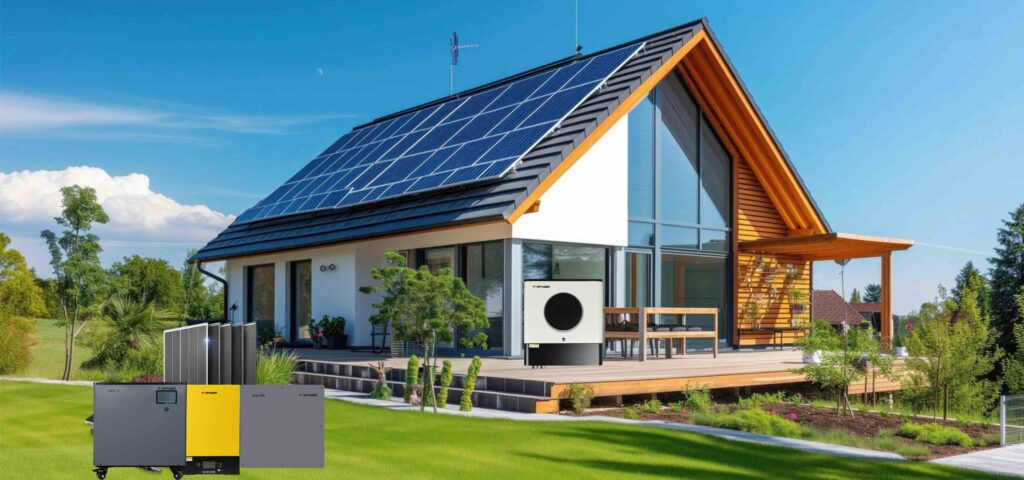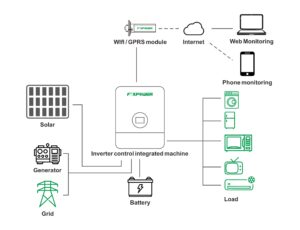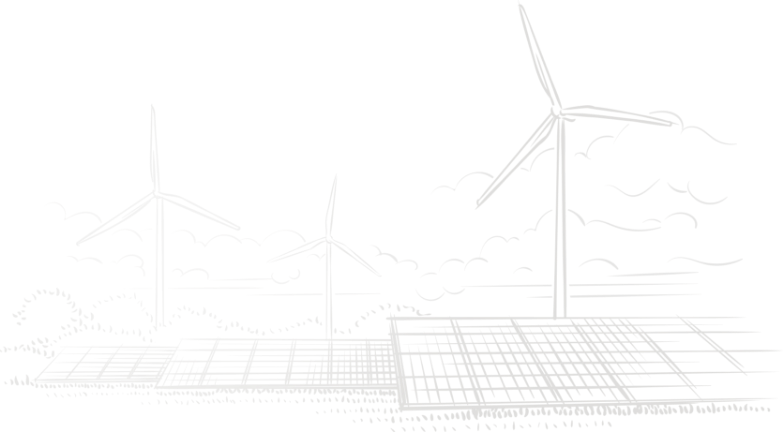There are many benefits of photovoltaic plus energy storage. First, it can ensure a more stable and reliable power supply. The energy storage device is like a large battery that stores excess solar power. When there is insufficient sunlight or a large demand for electricity, it can provide electricity to ensure continuous power supply.
Secondly, photovoltaic plus energy storage can also make solar power generation more economical. By optimizing operation, it can allow more electricity to be self-generated and self-used, reducing the cost of purchasing electricity. In addition, energy storage equipment can also participate in the power auxiliary service market to bring additional benefits. The application of energy storage technology makes solar power generation more flexible and meets various electricity needs. At the same time, it can also work with virtual power plants to achieve the complementarity of multiple energy sources and the coordination of supply and demand.
Photovoltaic energy storage is different from pure grid-connected power generation. It requires the addition of energy storage batteries and battery charging and discharging devices. Although the initial cost will increase to a certain extent, the application scope is much wider. Below we introduce the following four photovoltaic + energy storage application scenarios according to different applications: photovoltaic off-grid energy storage application scenario, photovoltaic off-grid energy storage application scenario, photovoltaic grid-connected energy storage application scenario and microgrid energy storage system application scenario.
- Photovoltaic off-grid energy storage application scenarios
Photovoltaic off-grid energy storage power generation system can operate independently without relying on the power grid. It is widely used in remote mountainous areas, areas without electricity, islands, communication base stations and street lights. The system consists of a photovoltaic array, a photovoltaic inverter, a battery pack, and power loads. The photovoltaic array converts solar energy into electrical energy when there is light, and supplies power to the load through the inverter, while charging the battery pack; when there is no light, the battery supplies power to the AC load through the inverter.
Photovoltaic off-grid power generation systems are specially designed for use in areas without power grids or areas with frequent power outages, such as islands and ships. Off-grid systems do not rely on large power grids, but rely on the working mode of “storing while using” or “storing first and using later”, which is a “helping hand in need”. For families in areas without power grids or areas with frequent power outages, off-grid systems are very practical.
- Photovoltaic on-grid and off-grid energy storage application scenarios
Photovoltaic on-grid and off-grid energy storage systems are widely used in applications such as frequent power outages, or photovoltaic self-generation for self-use without surplus power to the grid, high self-use electricity prices, and peak electricity prices that are much more expensive than trough electricity prices.
The system consists of a photovoltaic array composed of solar cell modules, a solar off-grid integrated machine, a battery pack, and a load. The photovoltaic array converts solar energy into electrical energy when there is light, and supplies power to the load through the solar control inverter integrated machine, while charging the battery pack at the same time; when there is no light, the battery supplies power to the solar control inverter integrated machine, and then supplies power to the AC load.
Compared with the grid-connected power generation system, the off-grid system adds a charge and discharge controller and a battery, and the system cost increases by about 30%-50%, but the application range is wider. First, it can be set to output at rated power when the electricity price is peak, reducing electricity expenses; second, it can charge in the valley period of electricity price and discharge in the peak period, making money by using the peak-valley price difference; third, when the power grid is out of power, the photovoltaic system continues to work as a backup power source, the inverter can be switched to off-grid working mode, and the photovoltaic and battery can supply power to the load through the inverter. This scenario is currently widely used in developed countries overseas.
- Photovoltaic grid-connected energy storage application scenarios
Grid-connected energy storage photovoltaic power generation systems generally operate in a photovoltaic + energy storage AC coupling mode. The system can store excess power generation and increase the proportion of self-generation and self-use. Photovoltaic is used in ground photovoltaic distribution storage, industrial and commercial photovoltaic energy storage and other scenarios. The system consists of a photovoltaic array composed of solar cell modules, a grid-connected inverter, a battery pack, a charge and discharge controller PCS, and power loads. When the solar power is less than the load power, the system is powered by solar energy and the grid. When the solar power is greater than the load power, part of the solar energy is used to power the load, and part is stored through the controller. At the same time, the energy storage system can also be used for peak-valley arbitrage, demand management and other scenarios to increase the system’s profit model.
As an emerging clean energy application scenario, photovoltaic grid-connected energy storage system has attracted much attention in my country’s new energy market. The system combines photovoltaic power generation, energy storage devices and AC power grid to achieve efficient use of clean energy. There are several major advantages:
- Improve the utilization rate of photovoltaic power generation
Photovoltaic power generation is greatly affected by weather and geographical conditions, and is prone to power generation fluctuations. Through the energy storage device, the output power of photovoltaic power generation can be smoothed, reducing the impact of power generation fluctuations on the power grid. At the same time, the energy storage device can provide energy to the power grid under low light conditions, improving the utilization rate of photovoltaic power generation.
- Enhance the stability of the power grid
The photovoltaic grid-connected energy storage system can realize real-time monitoring and regulation of the power grid and improve the operational stability of the power grid. When the power grid fluctuates, the energy storage device can respond quickly, provide or absorb excess power, and ensure the smooth operation of the power grid.
- Promote the consumption of new energy
With the rapid development of new energy such as photovoltaic and wind power, the problem of consumption has become increasingly prominent. The photovoltaic grid-connected energy storage system can improve the access capacity and consumption level of new energy and alleviate the peak load pressure of the power grid. Through the scheduling of energy storage devices, the smooth output of new energy power can be achieved.
- Application scenarios of microgrid energy storage system
As an important energy storage device, microgrid energy storage system plays an increasingly important role in the development of new energy and power system in my country. With the advancement of science and technology and the popularization of renewable energy, the application scenarios of microgrid energy storage system are constantly expanding, mainly including the following two aspects:
- Distributed power generation and energy storage system: Distributed power generation refers to the establishment of small power generation equipment near the user side, such as solar photovoltaic, wind power, etc., and the storage of excess power generation through the energy storage system to provide power during peak power consumption or when the power grid fails.
- Microgrid backup power supply: In remote areas, islands and other places, where grid access is difficult, microgrid energy storage system can be used as a backup power supply to provide stable power supply for the local area.
Through the complementary method of multiple energy sources, microgrids can fully and effectively tap the potential of distributed clean energy, reduce unfavorable factors such as small capacity, unstable power generation, and low reliability of independent power supply, ensure the safe operation of the power grid, and are a beneficial supplement to large power grids. The application scenarios of microgrids are more flexible, ranging from several kilowatts to tens of megawatts, and the application range is wider.
The application scenarios of photovoltaic energy storage are rich and diverse, covering off-grid, grid-connected, microgrid and other forms. In practical applications, each scenario has its own advantages and characteristics, providing users with stable and efficient clean energy. With the continuous development and cost reduction of photovoltaic technology, photovoltaic energy storage will play an increasingly important role in the future energy system. At the same time, the promotion and application of various scenarios will also help the rapid development of my country’s new energy industry and contribute to the realization of energy transformation and green and low-carbon development.







